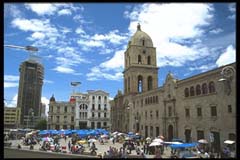La Paz Overview
Pedro de la Gasca, to whom the Spanish king had entrusted rule over the former Inca lands, commanded Captain Alonso de Mendoza to found a new city commemorating the end of the civil wars in Peru. Then the city of La Paz was founded on October 20th, 1548 under the name of La Ciudad de Nuestra Seбora de La Paz (The City of Our Lady of Peace). The city was first established in what today is Laja, on the Tiahuanaco road. Shortly after its founding, La Paz was moved to its present location, in the valley of the Chuquiago Marka.
On 1549, Juan Gutierrez Paniagua was commanded to design and urban plan that will designate sites for public areas, plazas, official buildings. La Plaza de los Espaбoles, what today constitutes the Plaza Murillo, was chosen as the location for government buildings as well as the cathedral.
Spain controlled La Paz with a firm grip and the Spanish king had the last word in all matters political. In 1781, for a total of six months, a group of Aymara people laid siege to the no longer peaceful city of La Paz. Under the leadership of Tupac Katari, they destroyed churches and government property. Thirty years later Indians laid a two-month siege on La Paz. In 1809 the struggle for independence from the Spanish rule brought uprisings against the royalist forces.

Today La Paz is a vibrant city, growing and expanding in all directions. La Paz has a population of more than a million inhabitants. La Paz is the official government site. While not the official capital, La Paz is the acting capital as well as the headquarters of the financial and commercial world in Bolivia, and as such is the highest capital city on earth, at 3800m altitude.
Lying in a natural basin protected from the harsh winds, 6600m high snow-capped Mount Illimani provides a spectacular backdrop to the city. Modern skyscrapers dot the city, offering contrasts to the more typical Spanish colonial, red-tiled roof buildings.
Main points of interest in the city include the San Francisco Church, built in 1549 with an interesting combination of baroque Spanish and native craftsmanship; the Museo Tiwanaku; and nearby Moon Valley with natural moon-like landscapes.
Save time to explore the streets surrounding the San Francisco Church. There are many handicraft shops, the Witch Doctor’s Market, and further up the hill the bustling daily market with goods, meat and produce of all kinds.
No visit to La Paz would be complete without a night visit to a “pena”, where you can experience the haunting music of the Andes and the colorful folkloric dances.
Presidential Palace: Also known as the Palacio Quemado (Burnt Palace) due to repeating fire episodes the building endured in the past.
The Cathedral: Built in 1835, the cathedral is an impressive building worth seeing. It is located in the Plaza Murillo nest to the Presidential Palace.
Casa de Pedro Domingo Murillo: Once the house of Pedro Domingo Murillo, martyr of the independence revolution of 1809 (hanged in the plaza that now bores his name) the house displays a collection of furniture, textiles, and art from colonial times.
Museo Costumbrista: Displays amazing ceramic dolls wearing traditional customs that show how was life in the early 1800's. Also displays are photos of old La Paz.
Museo Nacional de Arqueologia: Depicts a collection of artifacts of the Tiahuanacu culture.
Museo del Litoral: Displays objects from the 1879 war in which Bolivia lost its sea coast to Chile.
Museo del Oro: Depicts pre-Conquest works made of gold, silver and copper.
Museo de Etnografia y Folklore: This house built in the late 1700's exhibits customs and art of two ethnic groups. The Chipayas and Ayoreos.
Museo del Charango: Located in Calle Linares, the museum displays an incredible variety of this musical instrument. Other native instruments are displayed as well.
Museo de Historia Natural: Exhibits on Bolivia's paleontology, geology, paleontology, zoology, and botany. Casa Museo Marina Nuбez del Prado: Displays Quechua and Aymara-theme sculptures by Bolivian artist Marina Nuбez del Prado.
Museo Nacional de Arte: Located in calle Comercio, this former palace built in 1775, houses works by Melchor Perez de HolguЭn and Marina Nuбez del Prado, among others.
Mercado de Brujas (Witches' Market): Merchandise sold here includes herbs, remedies as well as other ingredients used in Aymara traditions.
Feria de Alasitas: This fair is celebrated each year on January 24 in honor of a little god of abundance known as Ekeko which mean dwarf in Aymara.
Valle de la Luna (Moon Valley): Located at about 10 Km from the city center, this eroded hillside maze of canyons and pinnacles creates a wonderful view.